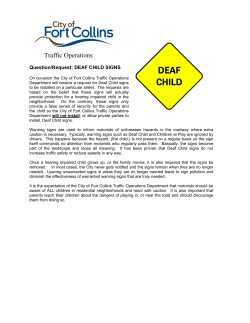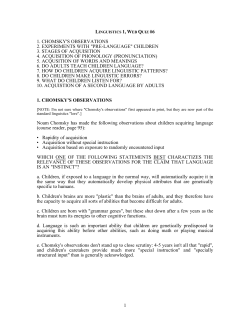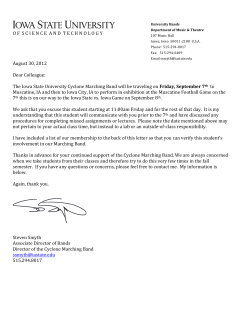
Document 70909
DOCUMENT RESUME
ED 386 765
AUTHOR
TITLE
PUB DATE
NOTE
PUB TYPE
EDRS PRICE
DESCRIPTORS
IDENTIFIERS
CS 509 024
Proctor, Russell F., II; Rock, Roseanna
Using "Children of a Lesser God" To Teach
Intercultural Communication.
20 Apr 95
11p.; Paper presented at the Annual Meeting of the
Central States Communication Association
(Indianapolis, IN, April 19-23, 1995).
Viewpoints (Opinion/Position Papers, Essays, etc.)
(120)
Speeches/Conference Papers (150)
MF01/PC01 Plus Postage.
Case Studies; *Communication Skills; *Cultural
Differences; Cultural Pluralism; *Deafness; Films;
Higher Education; *Instructional Effectiveness;
*Intercultural Communication; Lipreading; Sign
Language; Speech Communication; Undergraduate
Students
*Children of a Lesser God; Controversy
ABSTRACT
One film widely recommended as an instructional
resource for communication courses is "Children of a Lesser God," the
1986 movie starring Marlee Matlin and William Hurt. In this film,
which can serve as a case study, James Leeds, a talented young
teacher in a school for the deaf, falls in love with Sarah Norman, a
graduate of the school who, in Leeds' view, is underemployed as a
janitor. He offers to teach Sarah, who relies entirely on sign
language for communication, to speak and become part of the oral
culture. Sarah, however, is unwilling, as she feels comfortable with
her place in the deaf community. What will come out in the course of
class discussion of this movie is that James and Sarah's difficulty
in be.ng "joined" stems from their stubbornness regarding their
cultural beliefs. Sarah refuses to learn to read lips, while James
refuses to stop pressuring Sarah to speak. Sarah is uncomfortable in
a speaking culture, while James is uncomfortable in nonspeaking
culture. The film raises any number of issues related to the notion
of deafness as a culture rather than a handicap. Controversies about
culture, language, and identity make excellent topics for discussion
in communication classes. Instructors might ask their students: (1)
Do deaf people fit the definition of a culture/subculture as
d'..cussed in the lecture, the cou:se textbook, and the assigned
readings? (2) Who do you think is more stubborn, James or Sarah? (3)
Who do you think is more ethnocentric: James or Sarah? and (4) Should
deaf people learn to speak? Should hearing people learn to sign?
(Contains 19 references.) (TB)
******************************************;.A;.AAA.
'c*A****
Reproductions supplied by EDRS are the best that can be made
from the original document.
*
******************************************************************
U.S. DEPARTMENT OF EDUCATION
Office 0) Educationsi Reseiuch and Improvement
'PERMISSION 10 REPRODUCE THIS
MATERIAL HAS BEEN GRANTED BY
EDUCATIONAL RESOURCES INORMATION
CENTER (ERIC)
6/ his document hes been reproduced as
recewee from the person or organization
originating a
0 Minor changes have been made to mprove
reproduction quality
Pcpnts of %new or ornmons stated .n INS docu .
ment do not necessanly tepresent official
OERI position or policy
TO THE EDUCATIONAL RESOURCES
INFORMATION CENTER (ERIC1"
Using Children of a Lesser God
to Teach Intercultural Communication
Russell F. Proctor H
Roseanna Rock
Northern Kentucky University
This paper was presented at the annual meeting of the
Central States Communication Association, April 20, 1995
BEST COPY AVAILABLE
2
The use of feature films as case studies for illustrating communication concepts has been
popular in our field's journals (e.g., Adler, 1995; Griffin, 1995; Hodak, 1995; Johnson &
Iacobucci, 1995; McGowan, 1993; Proctor, 1993, 1995; Proctor & Adler, 1991; Siddens, 1992)
and textbooks (e.g., Adler & Rodman, 1994; Adler, Rosenfeld, & Towne, 1995; Canary & Cody,
1994; Griffin, 1994; Proctor, in press; Stewart & Logan, 1993). One feature film widely
recommended as an instructional resource is Children of a Lesser God, the 1986 movie starring
Marlee Matlin and William Hurt. Proctor and Adler (1991) suggest that Children "provides a
virtual survey of topics covered in most interpersonal communication classes" (p. 395). Griffin
(1994) details how Children illustrates relational dialectics, while Hodak (1995) describes the
movie's utility as a case study of relational stages. This paper will discuss how the movie can also
be used to illustrate concepts and issues of intercultural communication.
Film Synopsis
In the film version of Children of a Lesser God, Hurt plays James Leeds, a talented young
teacher who accepts a position at a. school for the deaf. Leeds uses a variety of creative methods
to teach his deaf students to speak. He soon falls in love with Sarah Norman (Matlin), a graduate
of the school who serves as its custodian. Sarah clearly is capable of a more challenging
occupation. Leeds decides she is held back only by her inability (or unwillingness) to engage in
oral communication. He offers to teach Sarah to speak, but she refuses. As the story unfolds, it
becomes clear that their differences are as much cultural as they are personal. James believes deaf
people are less than normal unless they speak, so he tries to make Sarah join his culturethe
culture of the spoken word. Sarah is more comfortable in the Deaf culture, where speech is not
deemed necessary for interaction or success. Her role model is Marian Loesser (pronounced
"Lesser"), a member of the Deaf community who does not speak and holds two doctoral degrees.
Viewed as an intercultural story, the movie raises difficult questions regarding value judgments
about cultural differences. At film's end, James and Sarah realize that the success of their
relationship will depend on their ability to bridge the cultural gap that separates them.
3
Deafness as Culture
The, notion of Deafness' as culture is a relatively recent departure from the traditional view of
deafness as pathology. The cultural approach suggests "it makes more sense to understand
deafness not as a handicapping condition, let alone as a deficit, but rather, as a cultural condition"
(Reagan & Wilson, 1994, p. 1070). From this perspective, the Deaf "are simply a linguistic
minority (speaking American Sign Language) and are no more in need of a cure for their
condition than are Haitians or Hispanics" (Dolnick, 1993, p. 37). Deafness as culture has been
espoused by a growing number of Deaf and hearing linguists, sociologists, and anthropologists
(see Reagan & Wilson, 1994, for an extensive bibliography).
The American Deaf community has many characteristics that typically define a culture or
subculture, such as:
.
.
. a distinctive language (American Sign Language), endogamous marital patterns,
behavioral norms that differ from those of the dominant society, cultural artifacts such as
telecommunication devices for the deaf (TDD), teletypewriters (TTY), television
decoders, and so on, a sense of the history of the Deaf community, and an awareness of
cultural identity. (Reagan & Wilson, 1994, pp. 1070-71)
This "awareness of cultural identity" was noted by Solomon (1994) after extended interaction
with the Deaf community:
I have heard Deaf people talk about how their 'family' is the Deaf community. Rejected in
so many instances by parents with whom they cannot communicate, united by their
struggle with a world that is seldom understanding of them, they have formed inviolable
bonds of love of a kind that are rare in hearing culture. (p. 45)
Despite these "inviolable bonds," there is controversy within the Deaf community. ASL is
generally understood within the American Deaf culture as the shared language that creates their
shared identity (Dolnick, 1993), but there is disagreement about whether the Deaf should learn
oral communication skills. For some, speaking and lipreading are seen as concessions to a
Li
4
pathological approach to deafness, as identified by Reagan and Wilson (1994): "If one accepts
the pathological view of deafness, then the only reasonable approach to dealing with deafness is to
attempt to remediate the problem--which is, of course, precisely what is done when one focuses
on the teaching of speech and lipreading in education" (pp. 1069-70). Some among the Deaf
believe the teaching of speech (also known as "oralism") suggests that ASL is an inadequate or
inferior form of communication; thus, they vehemently oppose such training. Others recommend
learning both ASL and spoken English (although some in this camp advocate ASL as the primary
language of the Deaf, written English as a secondary language, and oralism simply as an option).
Opinions about oralism among the Deaf range from strong endorsement to fervent abstention.
The oralism controversy is a central issue in Children of a Lesser God. It is also at the heart
of recent debates about Heather Whitestone, 1995's Miss America. "I feel caught between the
hearing and deaf worlds," says Whitestone (Anders, 1995, p. 4), who is deaf and speaks. Rather
than holding Whitestone in esteem, some in the Deaf community believe she has sold out to the
the hearing culture. "Among the deaf," says Sherry Cuhon of Gallaudet University, a liberal arts
university for the deaf, "status comes from using American Sign Language, attending (deaf)
schools and coming from a deaf family. That's our culture
.
.
.
that's why there's this
disappointment in Heather" (p. 5). One administrator at Gallaudet reflects, "A lot of us feel she
shouldn't represent us to the mainstream world," while another Gallaudet administrator applauds
Whitestone for "demonstrating that deaf people can succeed in reaching their goals in ways that
work best for them" (p. 4). The debate has been painful for Whitestone, who says, "I've never
advocated one communication method over another. It hurts me to be misunderstood" (p. 5).
Children of a Lesser God star Marlee Matlin, who was criticized for speaking at the 1987 Oscar
ceremony, empathizes with Whitestone: "This is the same thing that happened to me" (p. 5).
These controversies about culture, language, and identity make excellent topics for discussion
in communication courses. Children qf a Lesser God serves as a rich case study, introducing
students to some of the delicate and difficult issues in this complicated debate.
5
Case Study: Children of a Lesser God
In Children of a Lesser God, James Leeds views deafness as pathological and regards oralism
as a means for deaf people to better themselves. His job is to teach speech to students at a school
for the deaf. Leeds is dismayed to find that Sarah Norman, a bright graduate of the school,
cannot speak and works as a janitor. In their first interaction, James informs Sarah, "If you let
me, I bet I could teach you to speak." A few scenes later, his feelings about the importance of
oralism are revealed: "You should let me help you. Don't you want to get along in the world?"
Sarah responds, "I don't do anything I can't do well." By this point, battle lines are already drawn
for the characters--and the audience. Some will see Sarah as a stubborn, ungrateful persor who
refuses to learn (from someone who loves her) a skill that might help her advance in the "real
world." Others will see James as an insensitive, controlling teacher who refuses to acknowledge
both the legitimacy of the Deaf culture (which includes success stories such as Marian Loesser's)
and the embarrassment Sarah feels when she attempts oralism.
The existence (and potential) of the Deaf culture is not introduced until late in the movie. The
prevailing sentiment of the characters early in the film is that deafness is an unfortunate problem
that can be offset (but not cured) through education and oralism. Mr. Franklin, the school's
principal, tells James that his goal is simply "to help a few deaf kids get along a little better." He
informs James that Sarah is "content" with her janitorial job because, "We educated her--she's
productive" (similar to a message that, according to Solomon, 1994, is often given to non-trlaring
children: "You're deaf; don't shoot too high"). Wanting more for Sarah, and wanting to know
more about her, James visits Sarah's mother (Piper Laurie). Mrs. Norman's ethnocentric frame
for understanding deafness is revealed when she tells James how Sarah hid her deafness well as a
child: "If you didn't know there was a problem, you would have thought she was perfectly
normal." Sarah exposed her deafness only when she attempted to speak, at which point she
"looked awful, she sounded awful--people made fun of her." Mrs. Norman also admits to James
that she never learned to sign; thus, she and Sarah "don't communicate very well," for reasons
6
similar to those outlined by Dolnick (1993):
Many people never meet a deaf person unless one is born to them. Then parent and child
belong to differerent cultures, as they would in an adoption across racial lines.
.
.
.
The
crucial issue is that hearing parent and deaf child don't share a means of communication.
Deaf children cannot grasp their parents' spoken language, and hearing parents are
unlikely to know sign language. (p. 38)
Mrs. Norman is not the only person caught between cultures; Sarah and James face a similar
dilemma. Their differing competencies in cross-cultural situations can be seen in their behaviors
at the parties they attend together. When Sarah goes to a poker party in James's culture (at Mr.
Franklin's home), she adapts her communication to fit the context. She uses sign language
sparingly and slowly, making sure she is understood by all in the room. Sarah prepares for the
party by studying poker rules; thus, she does quite well at the game. Unfortunately, her success is
attributed to James's teaching ("You're really doing great with her, Jim" and "Did you teach her
that trick?"). James, on the other hand, is a fish out of water at a party with Sarah's deaf friends.
Although he is familiar with sign language, he is unnerved by their speedy and silent signing ("I
just feel like everyone's talking in some foreign Northern Hungarian dialect"). As a result, he
retreats (sulks?) in another room. He appears unimpressed by (jealous of?) Marian Loesser, a
successful member of the Deaf culture whom Sarah reveres.
The Deaf party leads to a fight when Sarah and James return home. James's contempt for
Sarah's refusal to speak surfaces in phrases such as, "I think it's pride that keeps you from
speaking right" and "If you want to talk to me, learn my language" (a phrase reminscent of a
disclosure Sarah makes to James earlier in the movie, when she tells him that adolescent boys
wanted her body but "they never learned to speak my language"). Her disdain for the way James
talks to her comes out when she tells him he treats her "like an idiot" and "pities" her; she then
declares, "No one's ever going to speak for me again." Sarah explains to James that she will not
forsake autonomy for connection. She touches her forefingers to her thumbs (creating two
7
circular "okay" signs) and says, "This sign--to connect. Simple, but it means so much more when
I do this." Sarah then links the two circles together and describes the difficulty of merging their
worlds:
.
.
.
It means to be joined in a relationship--separate, but one. That's what I want. But
you think for me--think for Sarah--as though there was no 'I. "She will be with me, quit
her job, learn how to play poker, leave Orin's party, learn how to speak." That's all you,
not me. Until you let me be an 'I' the way you are, you can never come inside my silence
and know me, and I won't let myself know you. Until that time, we can't be like this:
joined.
James and Sarah's difficulty in being "joined" stems in part from their stubbornness regarding
their cultural beliefs. Sarah refuses to learn to read lips, which could assist her communication
with the speaking culture. James refuses to stop pressuring Sarah to speak, even after he
promises to drop the subject. Sarah leaves James after their post-party fight, believing their
cultural differences are too great. At film's end, they reunite and conclude that the success of
their relationship will depend on their ability to bridge the cultural gap that separates them. Like
Tony and Maria in West Side Story, they are intercultural lovers in search of a "s)rnewhere"--or,
as James puts it, a "place where we can meet not in silence, and not in sound."
Instructional Suggestions
Proctor and Adler (1991) and Proctor (in press) offer general instructions for using feature
films as instructional resources. Specific recommendations L.'or using Children of a Lesser God
include having students read selected articles (e.g., Anders, 1995; Dolnick, 1993; Solomon, 1994)
prior to or after viewing the film, then posing questions in class discussions, outside assignments,
and/or exam essays, such as:
I. Do deaf people fit the definition of a culture/subculture as discussed in (a) lecture, (b) the
course textbook, (c) the assign !d readings?
2. Who do you think is more stubborn: James or Sarah?
8
3. Who do you think is more ethnocentric: James or Sarah?
4. Who do you think is more intr :culturally competent: James or Sarah?
5. Should deaf people learn to speak? Should hearing people learn to sign?
6. What comments/issues from the readings are illustrated in Children of a Lesser God?
Conclusion
Children of A Lesser God provides an excellent case study of interpersonal topics such as
relational stages/dialectics, power and control, and nonverbal communication. This paper
suggests that the film can also be a valuable tool for introducing students to cultural issues
involving the Deaf community. By exposing students to worlds and issues with which they might
be unfamiliar, Children can be a powerful educational resource in the communication classroom.
9
Footnotes
'Following the lead of Reagan and Wilson (1994), "In writing about deafness and the Deaf from
a sociocultural perspective, the common convention is to use 'Deaf to refer to the cultural
condition of deafness, and 'deaf to refer to the audiological condition of deafness" (p. 1070).
References
Adler, R. B. (1995). Teaching communication theories with Jungle Fever. Communication
Education, 44, 157-164.
Adler, R. B., & Rodman, G. (1994). Understanding human communication (5th ed.). Ft. Worth,
TX: Harcourt Brace.
Adler, R. B., Rosenfeld, L. B., & Towne, N. (1995). Interplay: The process of interpersonal
communication (6th ed.). Ft. Worth, TX: Harcourt Brace.
Anders, G. (1995, March 3-5). Beauty and the battle. USA Weekend, pp. 4-6.
Canary, D. J., & Cody, M. J. (1994). Interpersonal communication: A goals-based approach.
New York: St. Martin's.
Dolnick, E. (1993, September). Deafness as culture. Atlantic Monthly, pp. 37-53.
Griffin, C. L. (1995). Teaching rhetorical criticism with Thelma and Louise. Communication
Education, 44, 165-176.
Griffin, E. (1994). A first look at communication theory (2nd ed.). New York: McGraw-Hill.
Hodak, J. M. (1995). Children of a Lesser God: A film for relational study. Speech
Communication Teacher, 9, 3-4.
Johnson, S. D., & Iacobucci, C. (1995). Teaching small group communication with The Dream
Team. Communication Education, 44, 177-182.
McGowan, L. (1993). St. Elmo's Fire as a tool for discussing conflict management. Speech
Communication Teacher, 7, 12-13.
Proctor, R. F. (1993). Using feature films to teach critical thinking: Multiple morals to the stories.
Speech Communication Teacher, 7, 11-12.
U
10
Proctor, R. F. (1995). Teaching communication courses with feature films: A second look.
Communication Education, 44, 155-156.
Proctor, R. F. (in press). Feature films for teaching communication courses. Ft. Worth, TX:
Harcourt Brace.
Proctor, R. F., & Adler, R. B. (1991). Teaching interpersonal communication with feature films.
Communication Education, 40, 393-400.
Reagan, T. G., & Wilson, S. A. (1994, March). American sign language and deaf cultural studies.
Choice, pp. 1069-1077.
Siddens, P. J. (1992). Literary texts, films, and solo performances. Speech Communication
Teacher, 6, 7-8.
Solomon, A. (1994, August 28). Defiantly deaf. New York Times Magazine, pp. 39-68.
Stewart, J., & Logan, C. (1993). Together: Communicating interpersonally (4th ed.). New York:
McGraw-Hill.
ii
© Copyright 2025















